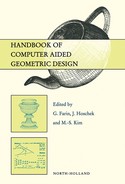Preface
CAGD - short for Computer Aided Geometric Design - is the discipline concerned with the computational and geometric aspects of free-form curves, surfaces and volumes as they are used, for example in CAD/CAM, scientific visualization, or computer animation. CAGD started in the 1960s, going back to efforts by Citroën and Rénault in France and by Boeing and General Motors in the U.S. Emerging from unrelated parallel developments, a coherent scientific discipline began to form in the 1970s, mainly due to the 1972 conference at the University of Utah, organized by R. Barnhill and R. Riesenfeld. About ten years later, the journal CAGD was founded by R. Barnhill and W. Boehm and published by North-Holland. Since then, the field has progressed significantly, as this handbook intends to document.
Drawing from many areas and influencing others, CAGD is inherently interdisciplinary. The earliest influences came from mechanical engineering in the form of new and puzzling problems in the emerging field of CAD/CAM. Their solutions involved results from approximation theory and differential geometry, but also from computer graphics and new software developments. Owing to these diverse roots, positioning CAGD within the science and engineering fields would be an ambitious endeavor. We think it is best to recognize the multiple origins and, from them, to expect a multitude of contributions to various scientific, engineering, mathematical, and other areas.
This handbook will thus not be able to cover every aspect of CAGD; yet it represents our best effort to provide a comprehensive collection of knowledge that has been collected to date. It contains the basics of curve and surface modeling (the very start of the discipline), many computer science and engineering aspects, and finally a rich coverage of mathematical underpinnings, ranging from geometry to approximation theory.
The intended audience for this volume are researchers from areas outside of CAGD wishing to get a broad yet thorough exposure to the field. Researchers inside the field will find a wealth of material to complement their expertise. Graduate students will find a guide to new and promising research areas, leading to MS and PhD theses. And a layperson should find enough material to simply get an appreciation of an exciting and unfolding discipline.
